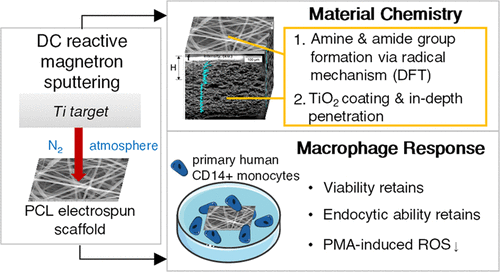当前位置:
X-MOL 学术
›
ACS Biomater. Sci. Eng.
›
论文详情
Our official English website, www.x-mol.net, welcomes your feedback! (Note: you will need to create a separate account there.)
Modification of PCL Scaffolds by Reactive Magnetron Sputtering: A Possibility for Modulating Macrophage Responses
ACS Biomaterials Science & Engineering ( IF 5.8 ) Pub Date : 2020-05-27 , DOI: 10.1021/acsbiomaterials.0c00440 Ksenia S. Stankevich 1, 2 , Valeriya L. Kudryavtseva 1, 3 , Evgeny N. Bolbasov 1, 4 , Evgeny V. Shesterikov 4, 5 , Irina V. Larionova 6, 7 , Yelena G. Shapovalova 6 , Liubov V. Domracheva 6 , Apollinariya A. Volokhova 1, 6 , Irina A. Kurzina 6 , Yuri M. Zhukov 8 , Anna B. Malashicheva 9, 10 , Julia G. Kzhyshkowska 6, 11 , Sergei I. Tverdokhlebov 1
ACS Biomaterials Science & Engineering ( IF 5.8 ) Pub Date : 2020-05-27 , DOI: 10.1021/acsbiomaterials.0c00440 Ksenia S. Stankevich 1, 2 , Valeriya L. Kudryavtseva 1, 3 , Evgeny N. Bolbasov 1, 4 , Evgeny V. Shesterikov 4, 5 , Irina V. Larionova 6, 7 , Yelena G. Shapovalova 6 , Liubov V. Domracheva 6 , Apollinariya A. Volokhova 1, 6 , Irina A. Kurzina 6 , Yuri M. Zhukov 8 , Anna B. Malashicheva 9, 10 , Julia G. Kzhyshkowska 6, 11 , Sergei I. Tverdokhlebov 1
Affiliation

|
Direct current (DC) reactive magnetron sputtering is as an efficient method for enhancing the biocompatibility of poly(ε-caprolactone) (PCL) scaffolds. However, the PCL chemical bonding state, the composition of the deposited coating, and their interaction with immune cells remain unknown. Herein, we demonstrated that the DC reactive magnetron sputtering of the titanium target in a nitrogen atmosphere leads to the formation of nitrogen-containing moieties and the titanium dioxide coating on the scaffold surface. We have provided the possible mechanism of PCL fragmentation and coating formation supported by XPS results and DFT calculations. Our preliminary biological studies suggest that DC reactive magnetron sputtering of the titanium target could be an effective tool to control macrophage functional responses toward PCL scaffolds as it allows to inhibit respiratory burst while retaining cell viability and scavenging activity.
中文翻译:

反应磁控溅射对PCL支架的修饰:调节巨噬细胞反应的可能性。
直流(DC)反应磁控溅射是增强聚(ε-己内酯)(PCL)支架生物相容性的有效方法。但是,PCL的化学键合状态,沉积涂层的组成及其与免疫细胞的相互作用仍然未知。在本文中,我们证明了在氮气气氛中钛靶材的直流反应磁控溅射导致在支架表面上形成含氮部分和二氧化钛涂层。我们提供了XPS结果和DFT计算支持的PCL碎裂和涂层形成的可能机理。
更新日期:2020-07-13
中文翻译:

反应磁控溅射对PCL支架的修饰:调节巨噬细胞反应的可能性。
直流(DC)反应磁控溅射是增强聚(ε-己内酯)(PCL)支架生物相容性的有效方法。但是,PCL的化学键合状态,沉积涂层的组成及其与免疫细胞的相互作用仍然未知。在本文中,我们证明了在氮气气氛中钛靶材的直流反应磁控溅射导致在支架表面上形成含氮部分和二氧化钛涂层。我们提供了XPS结果和DFT计算支持的PCL碎裂和涂层形成的可能机理。

























 京公网安备 11010802027423号
京公网安备 11010802027423号